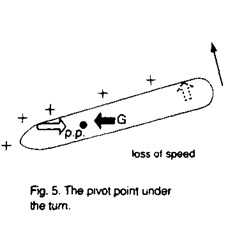Position of Pivot Point
The reason the pivot point is hard to place in shiphandling theory is probably due to the dual nature of the effect of underwater resistance. The major part of this resistance is made up of frictional drag and, as it takes place all along the hull, it has no effect on the position of the pivot point. Thus, we do not have to take it into account. 
Let us assume that the propulsion force has overcome frictional drag. In figure 4, the remainder of the propulsion force (roughly one quarter) is represented by a vector acting at the center of gravity G. At the bow, opposing the ship’s progress, is a vector representing the longitudinal resistance (about one quarter of the total underwater resistance). At constant speed the two vectors are of equal length, because otherwise the ship would accelerate/decelerate.
When the turn sets in under the effect of rudder, the initial pivot point will be between the bow and G. The position of G is indicated by the trim, and only when the ship is on an even keel is the position of G at middle length and the initial pivot point at one quarter length.
The ratio of longitudinal resistance to propulsion force (res/prop ratio) plays an important role in establishing the position of the pivot point. The direction of the propulsion force is the same as the ship’s heading, whereas the direction of the momentum lags, tending to continue in the original direction of motion.
Under the turn (fig. 5), the underwater pressure will spread from the bow along the ship’s side. With a widening of the drift angle, the ship’s side will be more exposed and the increase in pressure will cause a loss of speed. The pressure forward of the pivot point tends to push the pivot point closer to midships, while the pressure abaft the pivot point, by acting against the turn, limits the drift angle. On a directionally stable ship, the turn will eventually stop after the rudder has been put amidships.
A rotational motion may be the result of several forces acting on the ship simultaneously. The position of the pivot point then depends upon the magnitude and point of impact of the several forces acting on the ship. Since the pivot point is liable to shift with a change in magnitude or with a shift in point of impact of one of the forces acting on the ship, the several forces have a varying degree of leverage, depending upon the position of the pivot point.


Leave a Comment